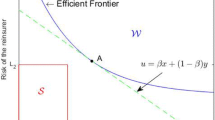Abstract
It is well-known that reinsurance can be an effective risk management solution for financial institutions such as the insurance companies. The optimal reinsurance solution depends on a number of factors including the criterion of optimization and the premium principle adopted by the reinsurer. In this paper, we analyze the Value-at-Risk based optimal risk management solution using reinsurance under a class of premium principles that is monotonic and piecewise. The monotonic piecewise premium principles include not only those which preserve stop-loss ordering, but also the piecewise premium principles which are monotonic and constructed by concatenating a series of premium principles. By adopting the monotonic piecewise premium principle, our proposed optimal reinsurance model has a number of advantages. In particular, our model has the flexibility of allowing the reinsurer to use different risk loading factors for a given premium principle or use entirely different premium principles depending on the layers of risk. Our proposed model can also analyze the optimal reinsurance strategy in the context of multiple reinsurers that may use different premium principles (as attributed to the difference in risk attitude and/or imperfect information). Furthermore, by artfully imposing certain constraints on the ceded loss functions, the resulting model can be used to capture the reinsurer’s willingness and/or capacity to accept risk or to control counterparty risk from the perspective of the insurer. Under some technical assumptions, we derive explicitly the optimal form of the reinsurance strategies in all the above cases. In particular, we show that a truncated stop-loss reinsurance treaty or a limited stop-loss reinsurance treaty can be optimal depending on the constraint imposed on the retained and/or ceded loss functions. Some numerical examples are provided to further compare and contrast our proposed models to the existing models.
Similar content being viewed by others
References
Arrow, K. J. (1963). Uncertainty and the welfare economics of medical care. American Economic Review, 53(5), 941–973.
Artzner, P., Delbaen, F., Eber, J., & Heath, D. (1999). Coherent measures of Risk. Mathematical Finance, 9(3), 203–228.
Asimit, V. A., & Badescu, A. (2013). Optimal risk transfer with multiple reinsurers. Insurance: Mathematics and Economics, 53(1), 252–265.
Balbás, A., Balbás, B., & Heras, A. (2009). Optimal reinsurance with general risk measures. Insurance: Mathematics and Economics, 44(3), 374–384.
Bernard, C., & Tian, W. (2009). Optimal reinsurance arrangements under tail risk measures. The Journal of Risk and Insurance, 76(3), 709–725.
Borch, K. (1960). An attempt to determine the optimum amount of stop loss reinsurance. In Transactions of the 16th International Congress of Actuaries, vol. I (pp. 597–610). Brussels.
Cai, J., & Tan, K. S. (2007). Optimal retention for a stop-Loss reinsurance under the VaR and CTE risk measures. ASTIN Bulletin, 37(1), 93–112.
Cai, J., Tan, K. S., Weng, C., & Zhang, Y. (2008). Optimal reinsurance under VaR and CTE risk measures. Insurance: Mathematics and Economics, 43, 185–196.
Cheung, K. C., Sung, K. C. J., & Yam, S. C. P. (2013). Risk-minimizing reinsurance protection for multivariate risks. Journal of Risk and Insurance. doi:10.1111/j.1539-6975.2012.01501.x.
Chi, Y., & Meng, H. (2013). Optimal reinsurance arrangements in the presence of two reinsurers. Scandinavian Actuarial Journal.
Chi, Y., & Tan, K. S. (2011). Optimal reinsurance under VaR and CVaR risk measures: a simplied approach. ASTIN Bulletin, 41(2), 487–509.
Chi, Y., & Tan, K. S. (2013). Optimal reinsurance with general premium principles. Insurance:Mathematics and Economics, 52(2), 180–189.
Chi, Y., & Weng, C. (2013). Optimal reinsurance subject to Vajda condition. Insurance:Mathematics and Economics, 53(1), 179–189.
Dhaene, J., Denuit, M., Goovaerts, M. J., Kaas, R., & Vyncke, D. (2002). The concept of comonotonicity in actuarial science and finance: theory. Insurance: Mathematics and Economics, 31(1), 3–33.
Gajek, L., & Zagrodny, D. (2004a). Optimal reinsurance under general risk measures. Insurance: Mathematics and Economics, 34(2), 227–240.
Gajek, L., & Zagrodny, D. (2004b). Reinsurance arrangements maximizing insurer’s survival probability. The Journal of Risk and Insurance, 71(3), 421–435.
Hurlimann, W. (1998). On stop-loss order and the distortion pricing principle. ASTIN Bulletin, 28(1), 119–134.
Jorion, P. (2006). Value at Risk: The New Benchmark for Managing Financial Risk (3rd ed.): McGraw-Hill.
Kahn, P. M. (1961). Some remarks on a recent paper by Borch. ASTIN Bulletin, 1(5), 265–272.
Kaluszka, M. (2001). Optimal reinsurance under mean-variance premium principles. Insurance: Mathematics and Economics, 28(1), 61–67.
Kaluszka, M. (2005). Optimal reinsurance under convex principles of premium calculation. Insurance: Mathematics and Economics, 36(3), 375–398.
Kaluszka, M., & Okolewski, A. (2008). An extension of Arrow’s result on optimal reinsurance contract. Journal of Risk and Insurance, 75(2), 275–288.
Rolski, T., Schmidli, H., Schmidt, V., & Teugels, J. (1999). Stochastic Processes for Insurance and Finance: John Wiley and Sons.
Tan, K. S., Weng, C., & Zhang, Y. (2011). Optimality of general reinsurance contracts under CTE risk measure. Insurance: Mathematics and Economics, 49(2), 175–187.
Young, V. R. (1999). Optimal reinsurance under Wang’s premium principles. Insurance: Mathematics and Economics, 25(2), 109–122.
Acknowledgments
Cong thanks the funding support from the Waterloo Research institute in Insurance, Securities and Quantitative finance (WatRISQ). Tan acknowledges research funding from the MOE Project of Key Research Institute of Humanities and Social Sciences at Universities(No. 11JJD790004), the Natural Sciences and Engineering Research Council of Canada and the Society of Actuaries Centers of Actuarial Excellence Research Grant.
Author information
Authors and Affiliations
Corresponding author
Rights and permissions
About this article
Cite this article
Cong, J., Tan, K.S. Optimal VaR-based risk management with reinsurance. Ann Oper Res 237, 177–202 (2016). https://doi.org/10.1007/s10479-014-1584-8
Published:
Issue Date:
DOI: https://doi.org/10.1007/s10479-014-1584-8



